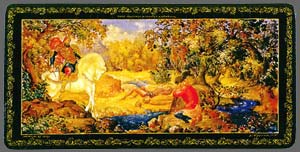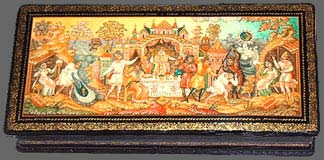|  here are four traditional centres of miniature lacquered
box painting in Russia, which today have become the most
famous. They are Fedoskino, Palekh, Mstera and Kholui. They
make up a tightly knit family, influencing each other and
enriching each other, with each one having its own individual
character. Mstera holds a special place in this group, due
to its more ancient and maybe more colourful traditions.
A special place in the Mstera icon painting tradition was
held by Byzantine art, the successors of which were first
and foremost the Vladimir and Suzdal icon painters.The Byzantine
technique of painting with flux and Byzantine icon painting
was preserved in Mstera for many centuries, right up until
the start of the 20th century.
here are four traditional centres of miniature lacquered
box painting in Russia, which today have become the most
famous. They are Fedoskino, Palekh, Mstera and Kholui. They
make up a tightly knit family, influencing each other and
enriching each other, with each one having its own individual
character. Mstera holds a special place in this group, due
to its more ancient and maybe more colourful traditions.
A special place in the Mstera icon painting tradition was
held by Byzantine art, the successors of which were first
and foremost the Vladimir and Suzdal icon painters.The Byzantine
technique of painting with flux and Byzantine icon painting
was preserved in Mstera for many centuries, right up until
the start of the 20th century.

"The Virgin of Vladimir"
17th century icon
|
In Russia, at the
end of the 19th century and at the beginning of the 20th
century, it was no accident that the creation and development
of the science of restoration of ancient Russian art was
closely associated with the names of the Mstera icon-painters
and restorers. It was they who became the main medium for
the reintroduction of "forgotten" ancient Russian
art among the St. Petersburg and Moscow professors of the
history of art. Almost the whole Mstera population was involved
to some extent with the icon-painting industry. As a rule,
icon-painting workshops were handed down from generation
to generation and were a family business. One of the largest
icon-painting workshops was that of Suslov (a man who came
from the shores of the White Sea) and the oldest was that
of the Old Believer, Yantsev.
After the revolution, the
private icon-painting workshops in Mstera were closed. The
hungry years after the revolution forced many inhabitants
of Mstera to move to the bread basket provinces. But the
majority stayed on in their home town of Mstera, where a
new life was gradually starting to come into being. In January
1923, the first group of former Mstera icon-painters was
formed.

A.Bryaguin. "Ilya Muromets and the Bandit Nightingale"
Casket. 1937
|
In January
1931, the cooperative decided to send a group of artists
to Moscow to study papier-mache art. In addition another
group was sent to Fedoskino to study lacquering and polishing.
It was then that a group of artists was formed to paint
objects made out of papier-mache. The 1930's played a very
important role in the further development of the genre.
This was because the art of miniature lacquer painting was
based on the traditions of Mstera icon-painting, which had
existed in that area for many centuries and the experienced
icon-painters and restorers became the basis for this new
art form.
The leading Mstera artist among the painters of
miniatures should by right be Nikolai Klykov (1861-1944).
It was he, who for a long time was the driving force behind
the search for an original style for the Mstera lacquered
miniatures. His former way of life no longer existed and
he was forced to find new ways of developing Mstera art.
In his early work, he used the traditions of the ancient
Russian miniatures of the 15th to 16th centuries. The most
attractive style for the artists was the Stroganov style.
He believed that the great delicacy and colourful variety
of this style was most ideally suited to papier-mache miniatures.

N.Klykov. "A landscape"
Casket. 1940
|
It is characteristic
for the period of "atheism", that the Mstera artists
did not stop depicting the sky in their miniature lacquered
works (unlike the Palekh artists who started to paint on
black lacquer). In this way, they were able to keep their
spiritual traditions going back to icon-painting, in which
the depiction of the sky as the real and celestial frontier
of this world, had enormous meaning. The 30's see many topical
works by N.P.Klykov. These works stand out due to their
sweet naivety, but it is this very naivety that often borders
on the sublime. And it is here that we see a harmonious,
stable and colourful way of life. Klykov painted works depicting
Russian folk tales and episodes from the works of Russian
writers, but hardly changed the landscapes in which his
contemporary heroes found themselves. In 1937, at the World
Exhibition in Paris, Klykov's work "Dubrovsky",
received a diploma and a gold medal.

I.Mamina "Honey summer"
Coffer. 2005
|
The
second generation of Mstera miniature artists were born
after the revolution and were trained at the technical and
artistic school that had been set up in 1932. Besides, the
creative talents of these young miniaturists was interrupted
by the Second World War. New period for the development
of Mstera miniature lacquered art was the start of the 1960s.
At that time, the visual arts, witch also included lacquered
miniatures, were under the influence of the so-called “sever
style”, with its generalizations, laconism and emphasized
decorativeness.

O.Malchikova "The Tale of the Fisherman and the little fish"
(after the tale of A.Pushkin)
Casket. 2006
|
In the 1970's, the development of Mstera lacquered miniature
painting went along the lines of not so much rejection of
the old esthetic ideals, but the creation of positive programs
for its further development. The new generation of artists,
who replaced those of the 60's, had no declared program,
but on the other hand, they had a strong desire to express
their own creative individuality. At the beginning of the
third millennium, there has been a flowering of Mstera art,
that is of icon painting and lacquering miniatures painting.
The creativity of the young artists make it possible to
look at Mstera art in term of an open system which is looking
to the future.
|